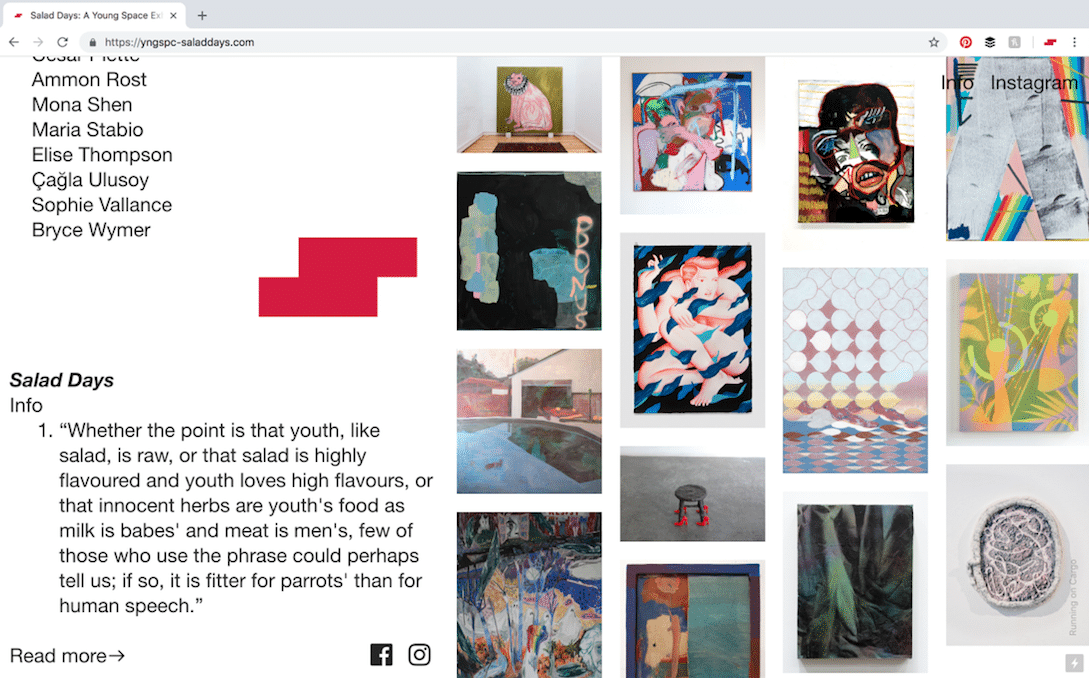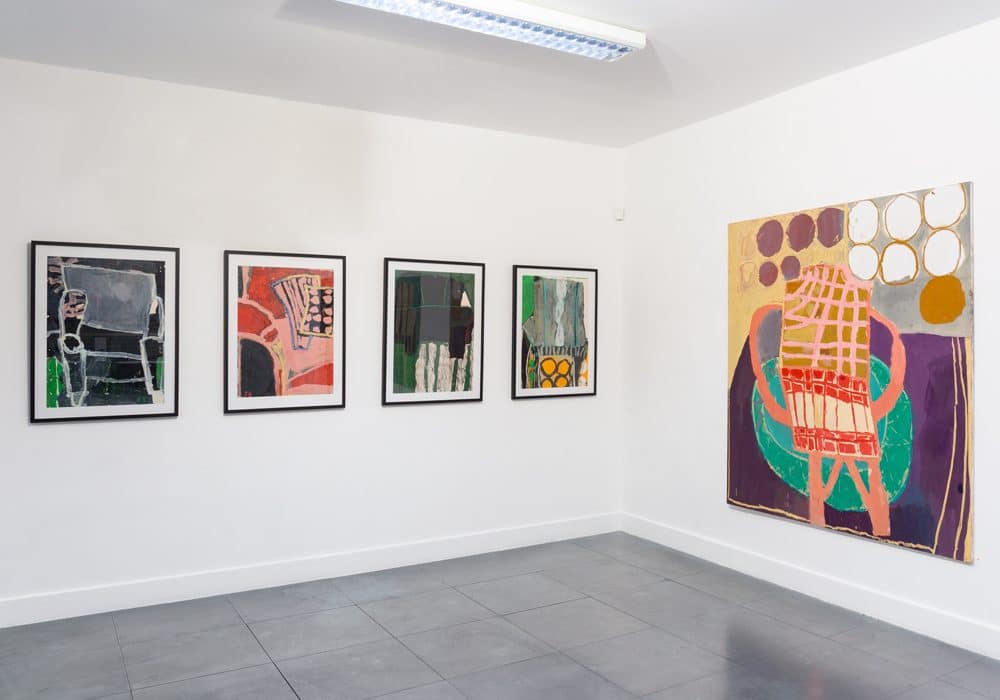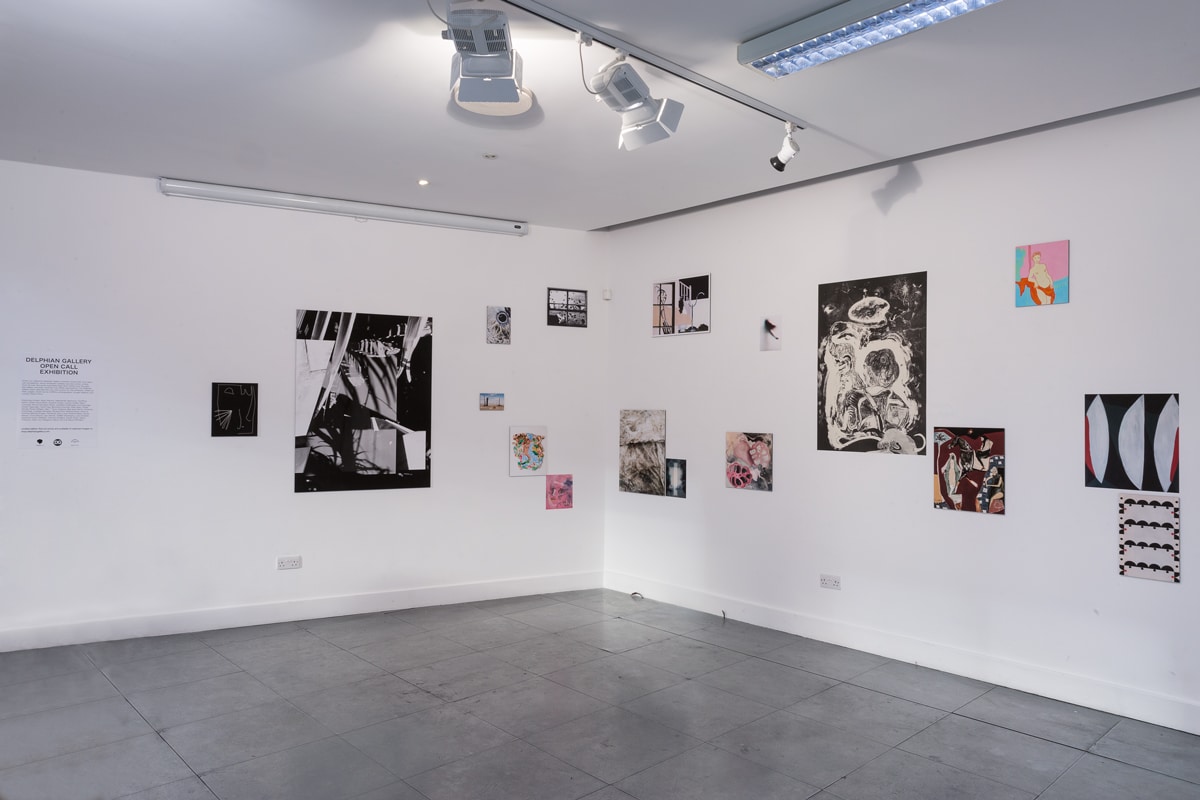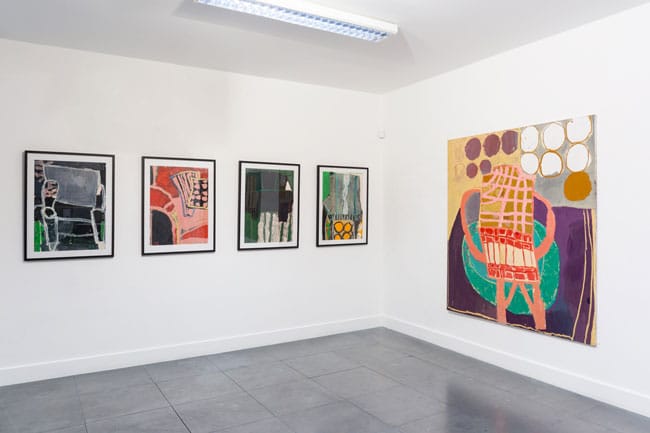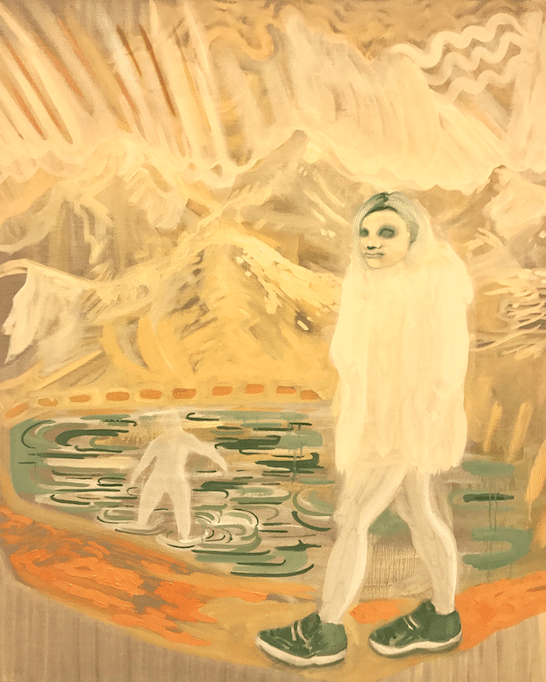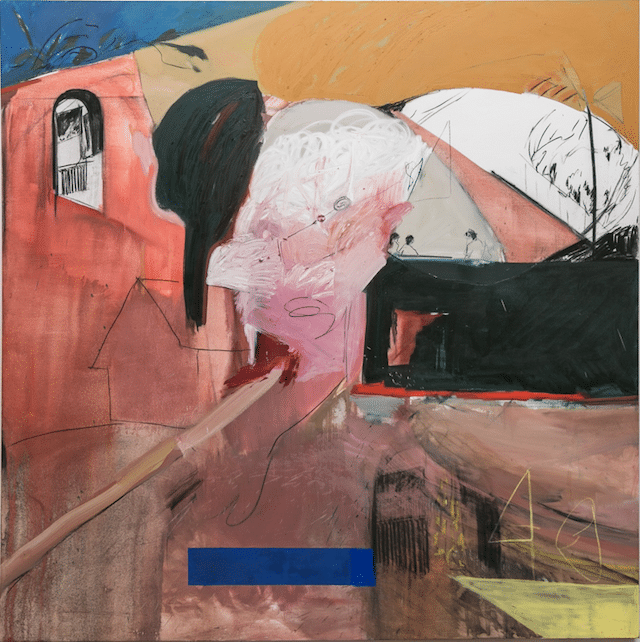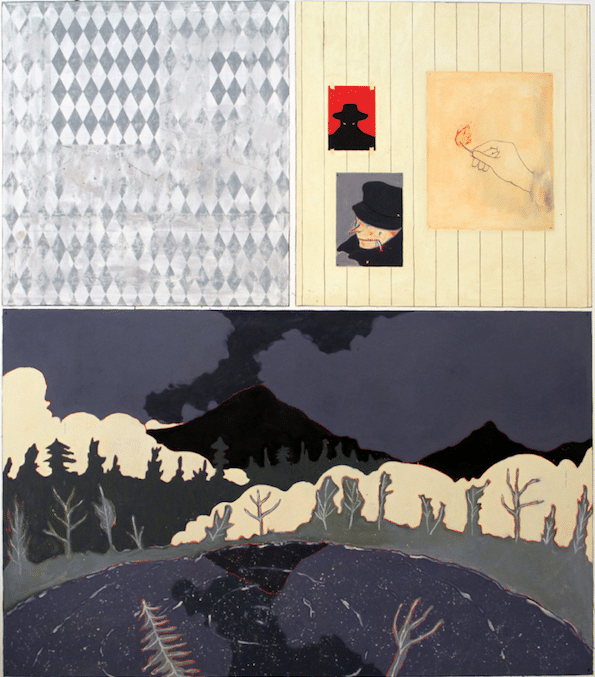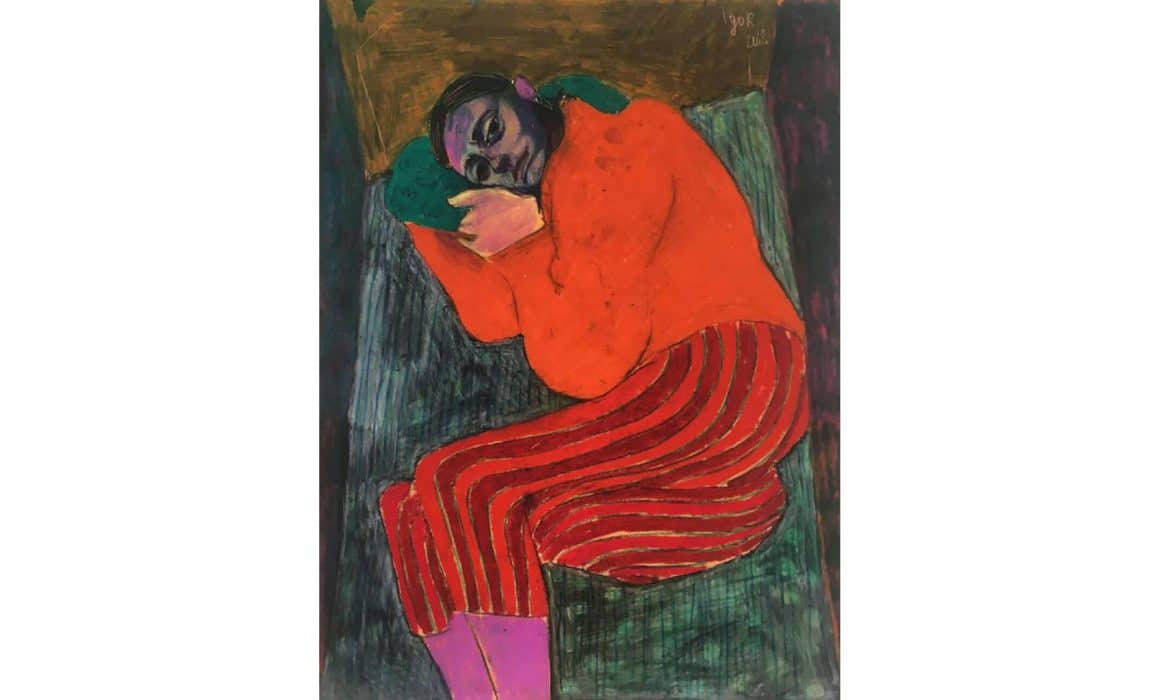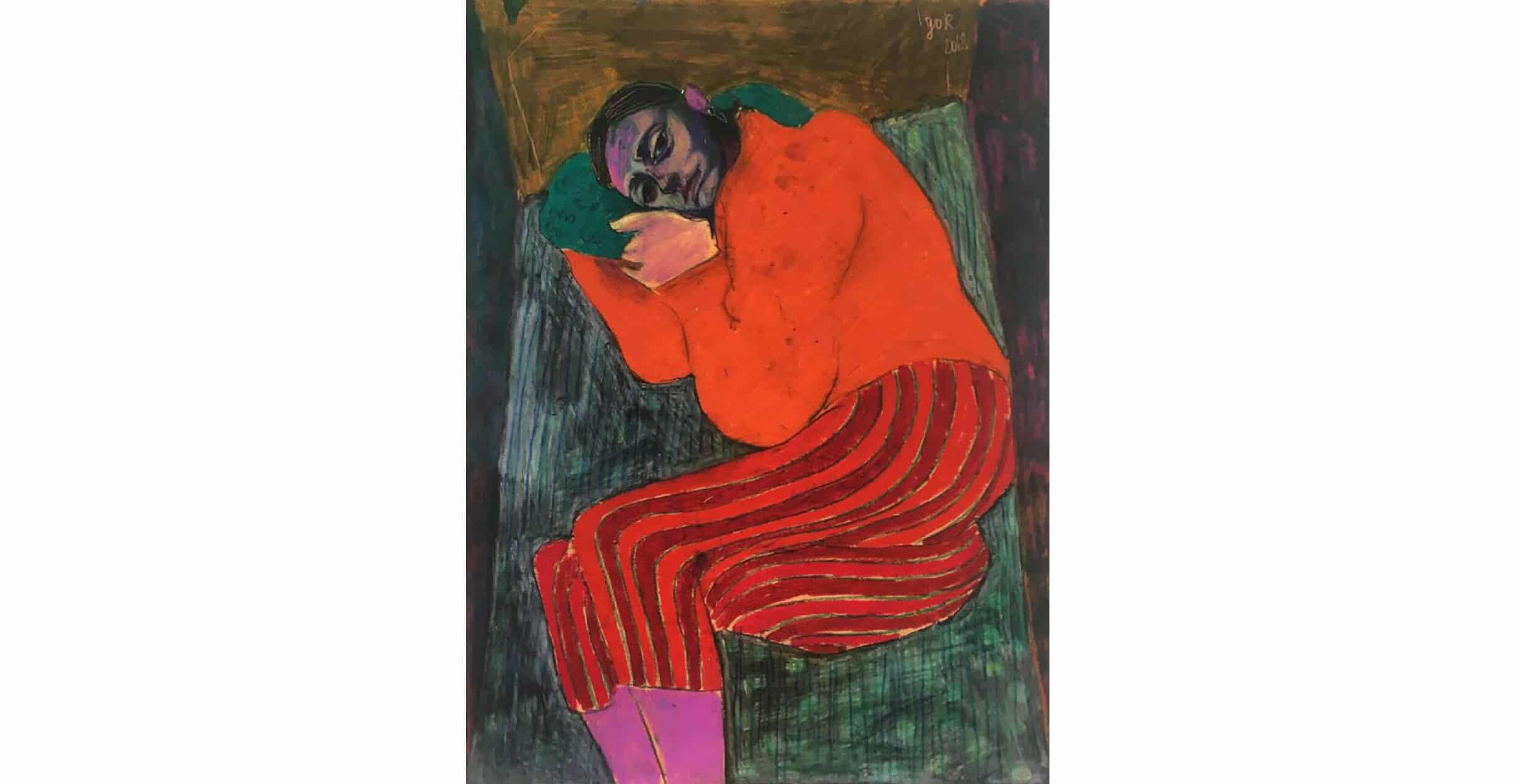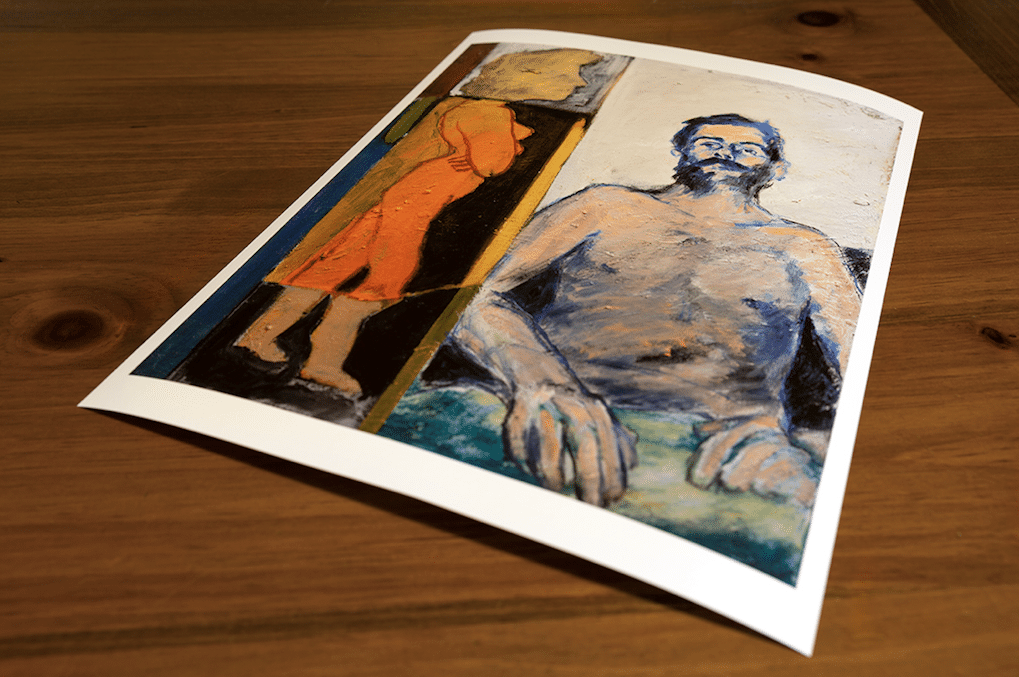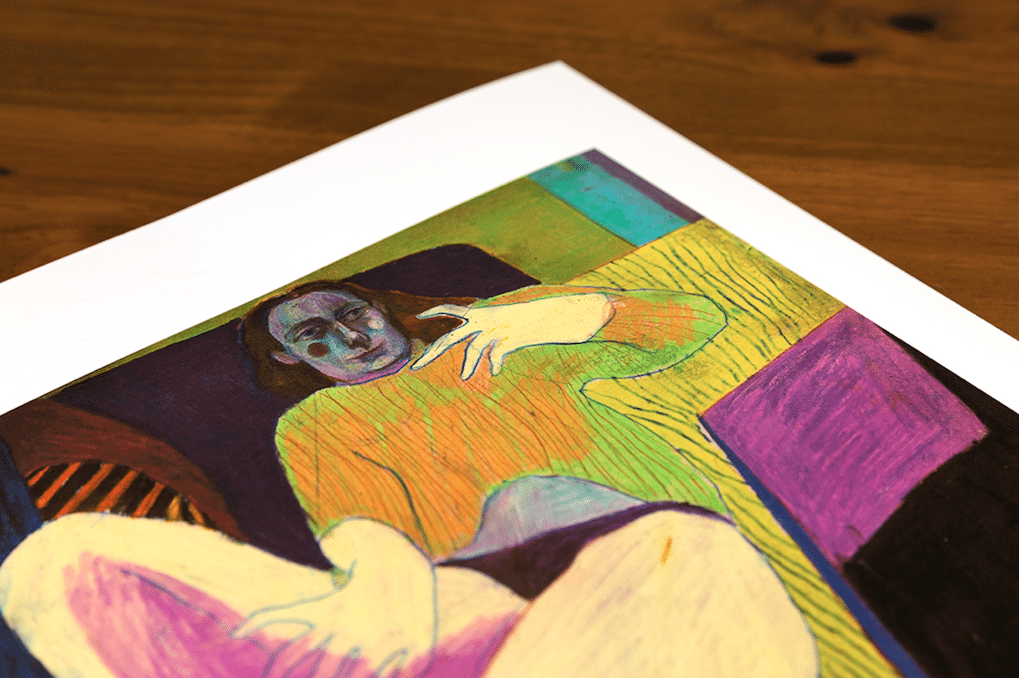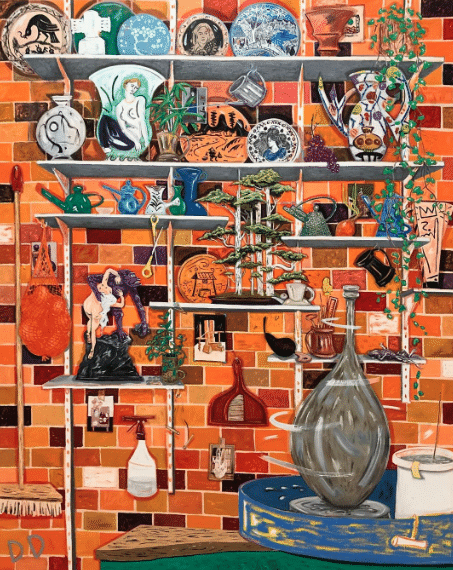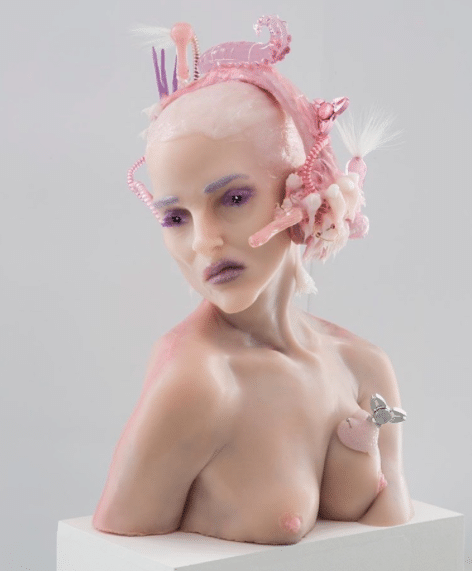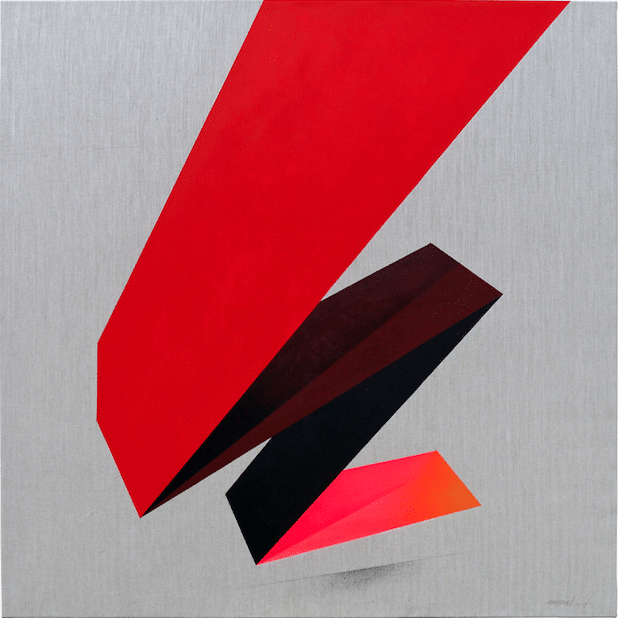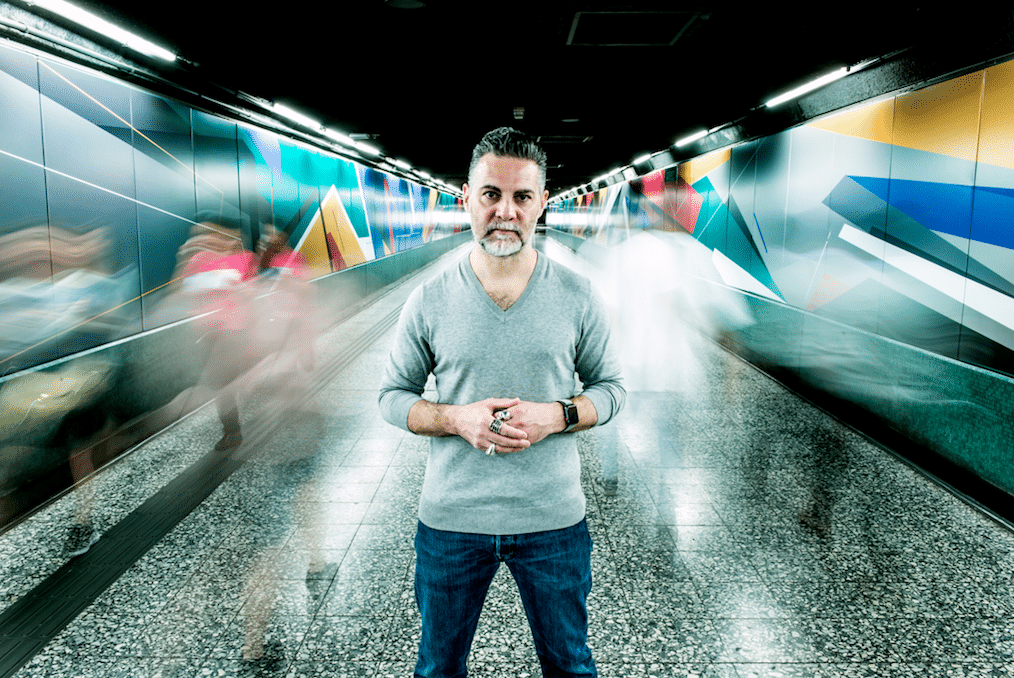Charley Peters in conversation with Remi Rough
Charley Peters is a painter. I don’t see her paintings as simply abstract, they are more about the formalism of painting itself, but she also uses the surfaces she works on as conveyances for her internal structures. There is an abundance of mathematics within her paintings, from the simple yet perfect gradients she often uses to the detailed repetitive shapes that are painstakingly drawn and subsequently painted into tiny masked off sections. Peters plays with the idea of how people consume and view her artworks on handheld screens so much so that some of her paintings look almost like digital glitches when seen on a phone. Her use of colour is bold and beautiful so it’s no wonder so many people have gravitated toward her work.In the ever changing landscape of the modern art world Charley Peters is a much needed agent of change.
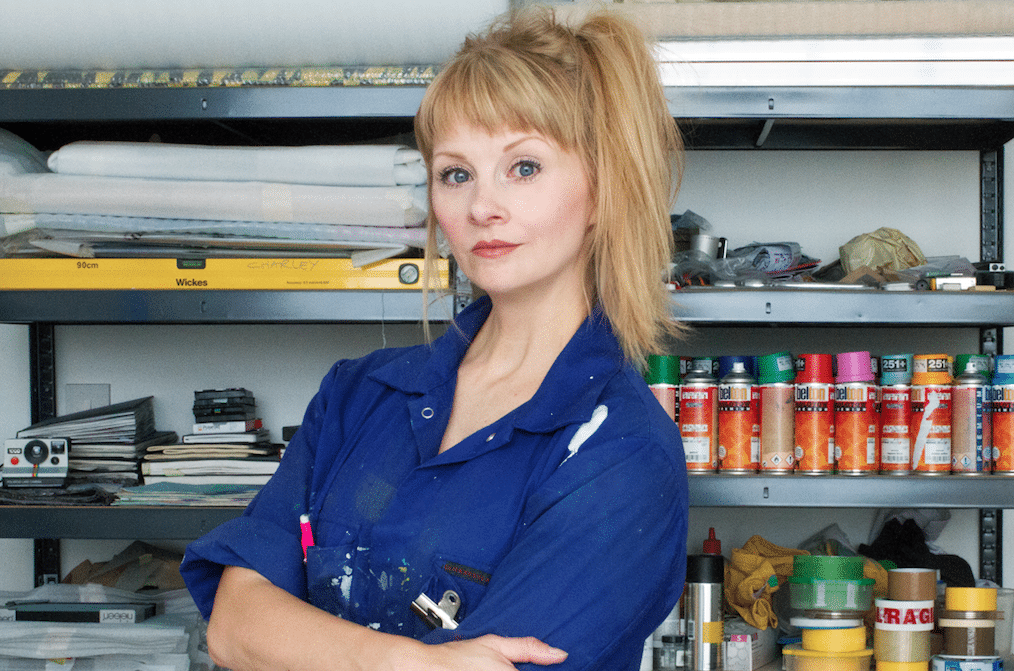
Charley Peters in the studio
You often utilise a mixture of materials in your paintings, I wondered how you initially engage with materials, did you purposely select them or was there more of an accidental discovery?
Could you also expand on your use of airbrush as I find this a really interesting medium?
I predominantly use acrylic paint, which I apply with a brush, and spray paint or acrylic paint run through an airbrush. The two ways of applying paint – by brush or by spraying – have very different sensibilities, and I like to offset one against the other. I like painting to be as engaged with the substance and appearance of paint as creating an ‘image’, so using paint in different ways enables me to generate a variety of surfaces within each work. When I paint with a brush it’s a slower and more controlled process, I use heavy body paint against tape, usually mixed to the consistency of soft butter and like it to be matt and opaque. Sprayed paint has a dewy quality, it’s very wet and more difficult to control, but I enjoy how tricky it is. It can be used to create solid, flat colour or if applied more sensitively, it’s possible to build up tones in translucent layers. I love how sprayed paint can suggest infinite pictorial depth, the way that light and colour are diffused by spraying is beautiful and almost otherworldly. Running acrylic paint through an airbrush allows me to create the effect of spray paint but I have more control over colour (obviously spray paint colours are pre-mixed) and it’s a more deliberate way of applying sprayed paint; controlled and precise but still with the capacity to appear gestural and fluid.
Could you describe your ideal painting? Have you made it yet? (I often ask myself this question by the way).
No, I don’t think I’ll ever make my ideal painting. I have paintings that I’m more satisfied with than others, some that I like on a purely instinctive level and others that I can’t stand the sight of. What I’d like to achieve in my paintings is a perfect balance of colour, composition and form. I break down the picture plane into different spatial areas of divergent visual information – all treated as individual components, but through the making of the work I hope to bring them all together to create a sense of harmony, as if all elements were always meant to be together. I don’t like my work when it is overworked or overcomplicated, paintings can be technically difficult to make and labour intensive but I don’t think they need to look like that’s the case. I suppose I want to look at my paintings and for them to just ‘be’ right. Of course, right is a highly subjective term and I often deliberately break rules and do things wrong in order to make the painting right in the end. And paint is a very spirited and rebellious medium, it sometimes does wrong things all by itself, which is also exactly the right thing for it to do.
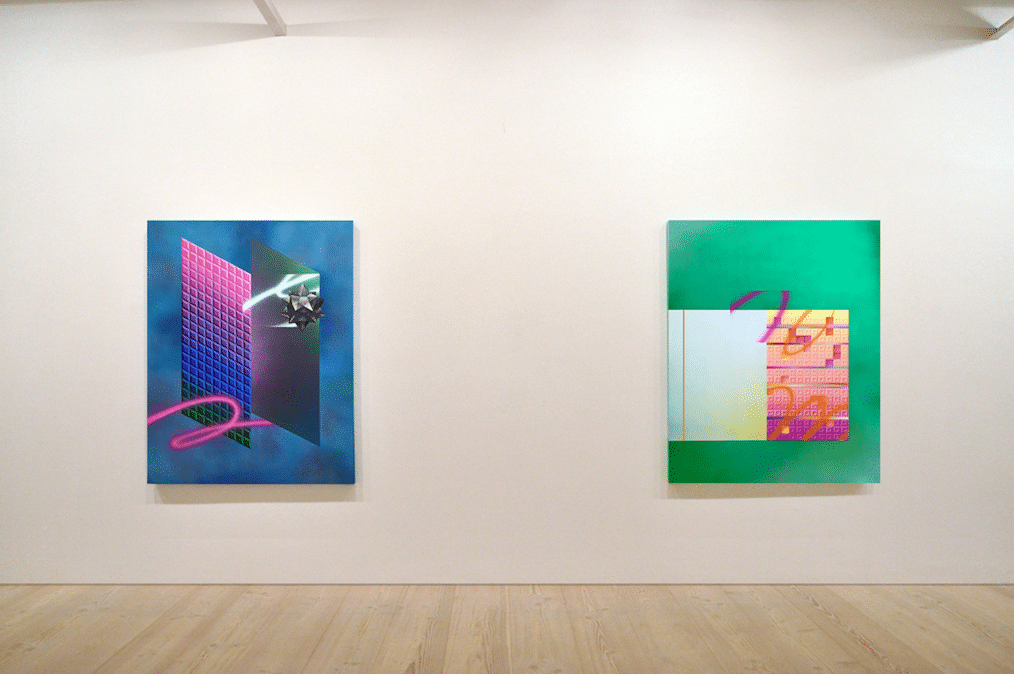
(L) ~NMH*NFM~ (2018), acrylic on canvas, 120cm x 150cm
(R) LM>Installed in Harder Edge: A Survey of Recent Abstraction, Saatchi Gallery, London (2018)
Having worked with you on numerous occasions, you seem to have a pretty loose approach to making your work yet they look so organised and pre-designed. Do you prefer to work to preset ideas or be more flexible?
I don’t organise or pre-design my work at all. Again, I think this relates to me trying to make the painting right or balanced from the starting point of a blank canvas. Making paintings for me is a very fluid process, there are some moments of logical thought and conscious decision making but mostly I rely on my intuition and impulsive actions. I never know what my paintings will look like once they are finished. I always start with applying colour to the painting’s surface, usually a flat, mid-tone colour that I’ve arrived at by not much thought at all…often just a sense of whether it might be hot or cold or bright or dark. After that I divide the surface up spatially and work on each area independently of the others. At this point I mask off large areas of the painting so can’t see much of what I’m doing. I’m working in the dark most of the time. I work in layers, similar to constructing images using Photoshop, I don’t consider the whole painting until it’s nearly finished. I usually paint on the floor and draw quick sketches as I paint as half-formed notions of what I might do next, but these are far from ‘working drawings’ and more like linear scribbles that barely make sense. Somehow they help me move through paintings until they can be considered finished. It’s a difficult way of working, like organising the chaos of not knowing where things are going – I end up changing my mind about things, adjusting colours or forms as I paint, I paint over things that have taken days of work – but it’s the best way for me. I like to go to the studio and leave my logical, overthinking mind elsewhere, I think I make better paintings that way.
Also, I wanted to respond to your introduction to my work in this interview, in which you describe ‘an abundance of mathematics’ within my paintings. I find ‘mathematics’ such an alien term. I find numbers impossible – I can’t read or remember them, even simple numerical systems like phone numbers and padlock codes confuse me and I get them wrong. I generally rely on visual maths in the studio, dividing spaces up by eye rather than measuring them. My rulers all have paint on them and I can’t easily read the numbers, if I count or add things up I have to do it several times and it is still wrong. It made me laugh when you used the word ‘mathematics’ as I’m not at all mathematical or precise when I work – I make a huge mess every time I do anything!
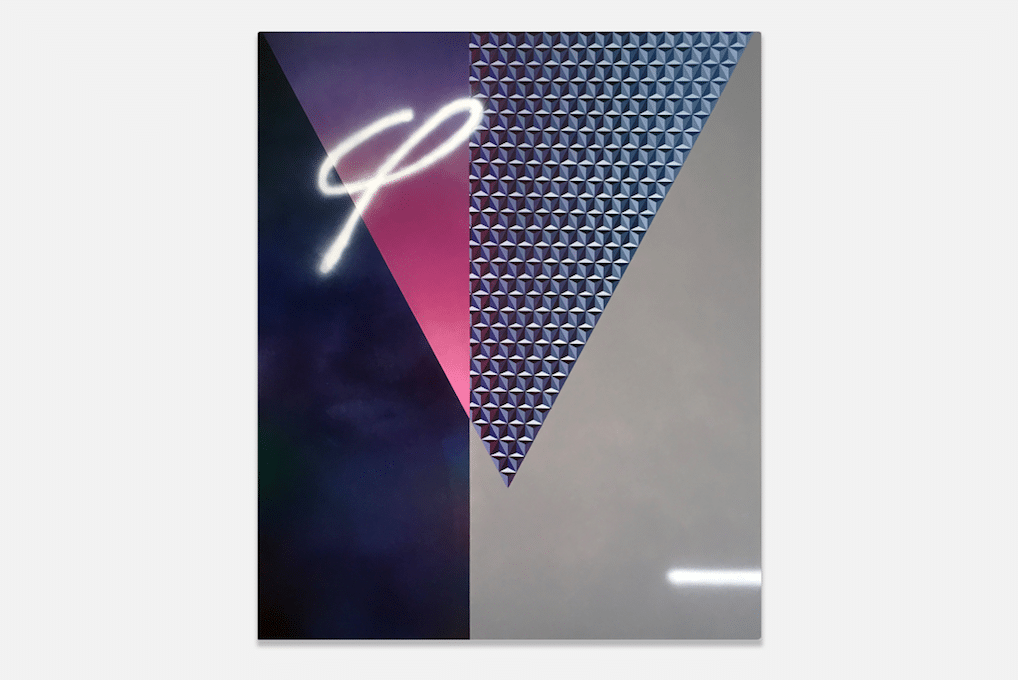
>THT< (2018), acrylic on canvas, 120cm x 150cm
There seems to be a renaissance of hard edge, more graphic work lately, is this a good thing or a bad thing? I often wonder if it hinders or helps myself?
It’s both good and bad. When there is an increased interest in a particular aesthetic or methodology it opens up more opportunities to show work and be part of an identifiable peer network of artists – this is mostly a good thing, it means we are relevant and interesting if only for a transient period of time. What can be bad about being ‘on trend’ is that people can stop being critical, they don’t see the good work from the bad, the innovative from the derivative. I’m uncomfortable with any sentimental or nostalgic positioning of particular genres of painting, and being associated with, for example, the hard edge or geometric abstraction, feels unthinking and too surface level a definition for what I think I should be making today. I’d prefer to think that I’m looking at the hard edge through the lens of contemporary visual media – and asking questions about the legacy of abstraction and what it is now. There is no point making work in a contemporary context that looks like it could have been made in the 1960s.
[Remi Rough] – I know you’re doing a writing residency later this year and wondered how important is that aspect of your work compared to painting?
[Charley Peters] – Painting is always more important, I’m a painter who writes. Writing about others’ work is a good way to articulate ideas within my own painting with an objectivity that is difficult when trying to be too self-reflective. I find writing a frustrating process, it’s far too logical and slow. More so than with painting I need some sort of plan or structure at the beginning and that pisses me off, it’s so boring. I make sense of the process of writing in a way that I can cope with. I write in layers, like I would make a painting, writing unrelated pieces of text that get expanded on or edited out in waves of activity until there’s a whole piece of writing with a beginning, middle and end. I see words as having a rhythm, colour or shape when put together in sentences and then they make sense to me as a resolved object. I think it’s as important to be critical when writing as it is to be critical when painting and I like my texts to have ideas and positions in them, even if I’m writing a review of an exhibition, I think there should be a more interesting subtext than merely discussing the show.
[RR] – Would you ever consider taking your work into a more sculptural plane?
[CP] – My paintings are ‘spatial’, they engage with the physical space of the canvas and the illusionary space that painting can create. I do think that they are as much objects as they are images or surfaces. I always consider that the edges of the paintings are part of the work, they are usually painted as an extension of the front of the canvas. I have also made several walk-in, or immersive, paintings – room-sized installations of wall and/or floor paintings – as well as smaller assemblages of disparate painted sculptural elements. Painting has the capacity to challenge our understanding of space and has a life that extends beyond being hung on a wall. Even the most benign rectangular canvas on a white gallery wall can manipulate and control space. I think it’s more important than ever to acknowledge painting’s sculptural potential in a world where most of what we experience is non-physical and seen on a screen.
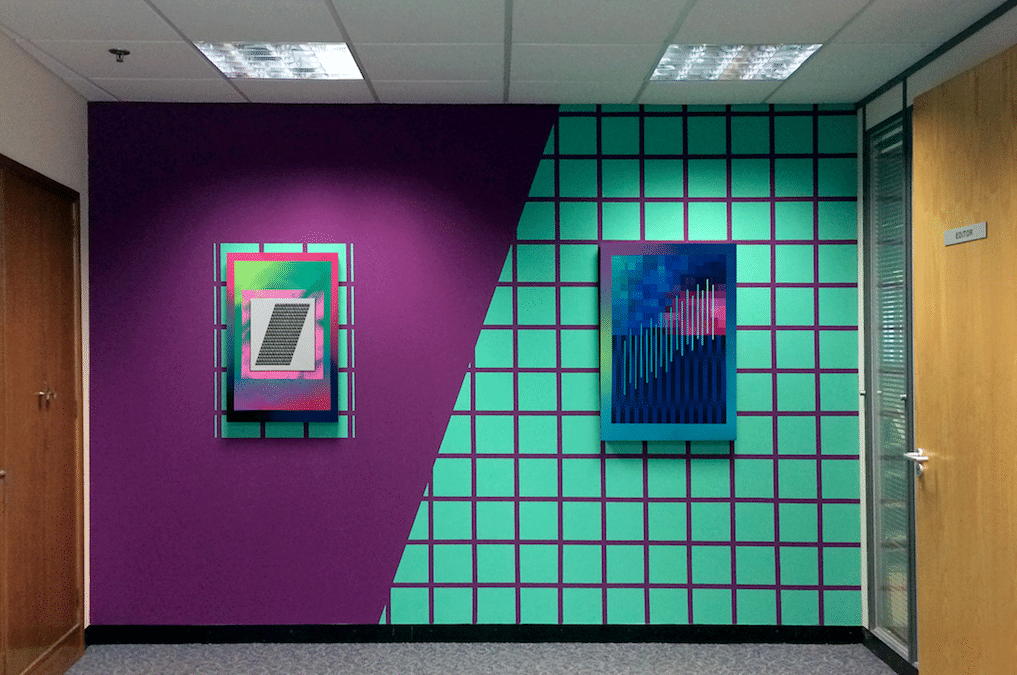
Editing Suite, Installed in The Future, Coventry Biennial of Contemporary Art, Coventry (2017)
Acrylic and spray paint on panel and wall painting
[RR] – Can you tell me about 3 artists dead or alive you have had a big influential impact on you and the way you work.
[CP] – Definitely Agnes Martin. Martin said that inspiration found her and that she could take no credit for it, she just emptied her head – especially of thoughts of herself – and inspiration would come into her ‘vacant mind’. This relates to what I was saying earlier about leaving my logical mind outside the studio. I think that painting became more interesting for me when I stopped planning, thinking and knowing what I was doing. Removing myself from the work as much as possible allows the paintings to make themselves – they feel more honest that way. I love Eva Hesse’s work, her bold and exploratory use of materials and textures is both intelligent and sensual. Sol LeWitt’s letter to Eva Hesse is something that I return to over and over again. It reminds me of the difficulties of making work and, again, the importance of ‘doing’ over thinking, worrying or second guessing. It’s a mistake to only credit him with that letter, he couldn’t have written it without her. And I’d also cite Carmen Herrera as being a significant figure for me. She exemplifies so well the strength and resilience of creative spirit, and makes shit hot paintings too.
[RR] – Do you think your artwork is a subjective window of your personality?
[CP] – That’s an interesting question…
Do you mean are my paintings a reflection of who I am, for example, an odd mixture of impulsiveness and discipline?! You should tell me – you know me well enough to say! I’m generally uncomfortable talking about my work in subjective terms. I have a formal painting practice, my concerns are with the relationships between colour, form and compositional space, and nothing emotional. I like how abstraction masks subjectivity so we can just see the work and nothing else. I’m certainly not positioning myself, my life experiences or opinions within my work and as such I’m resistant to any suggestion that my paintings are a representation, for want of a better word, of my personality. Of course, at times I may make subjective judgements on things like colour or when a painting is finished, but does that make ‘me’ part of the work? Sometimes if I’m tired or had a tough day does that affect the sensibility of my painting or the decisions I make in the studio? Maybe it does. You’ve asked a complicated question, and I can answer it by talking about my intentions for the work and how I like to consider my painting as a non-subjective entity. It’s possible that this isn’t entirely true though, it’s so difficult to say where decisions in the studio come from and how much of that is driven by intuition or experience.
Both artists are still exhibiting at the The House Of Saint Barnabus alongside Peter Lamb, and Charley is showing at Fold Gallery until the 2nd of March.
If you enjoyed Remi interviewing Charley, read Charley interviewing Remi HERE
The pair also have just released a print (with Peter Lamb), which can be bought HERE


